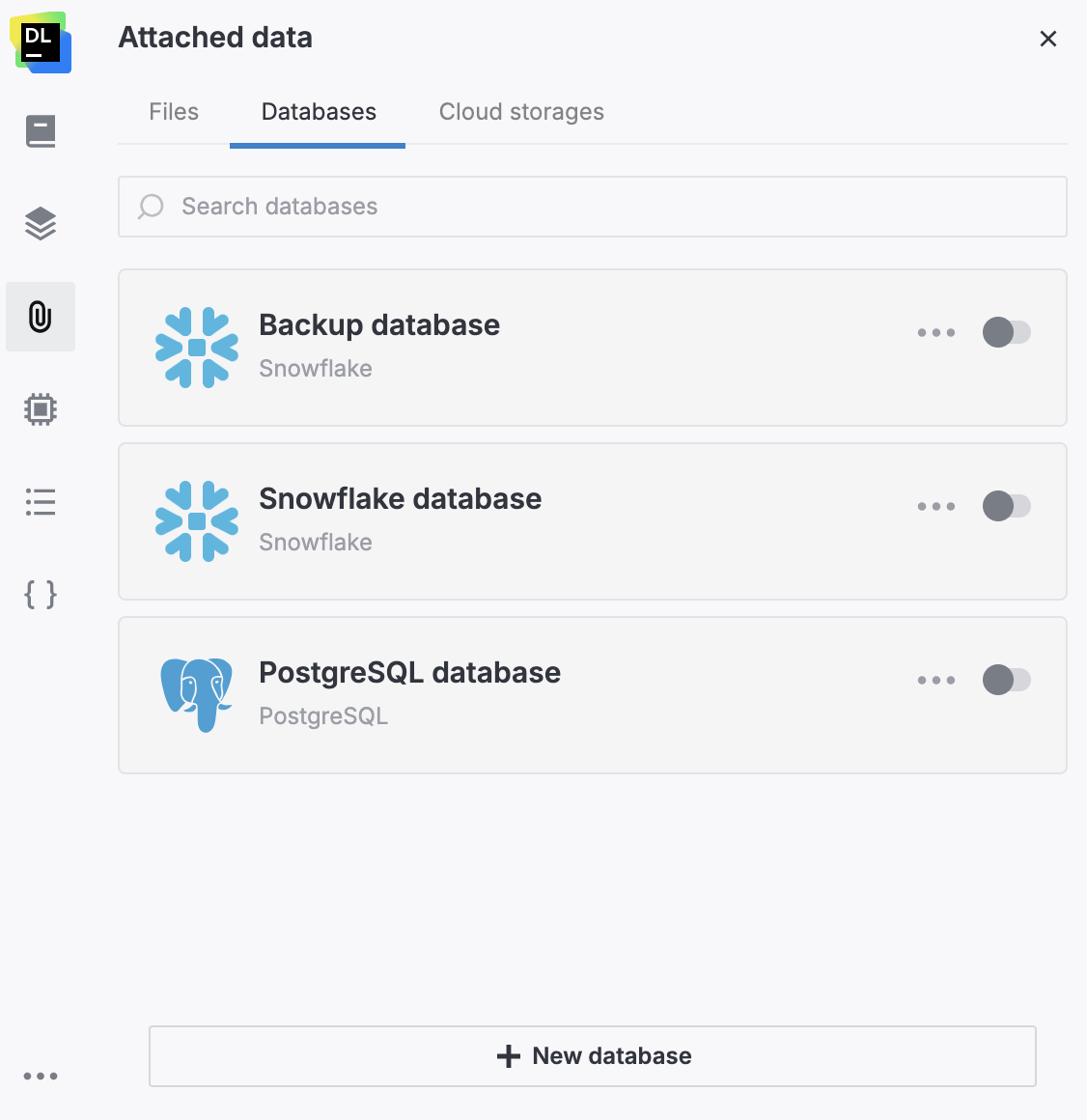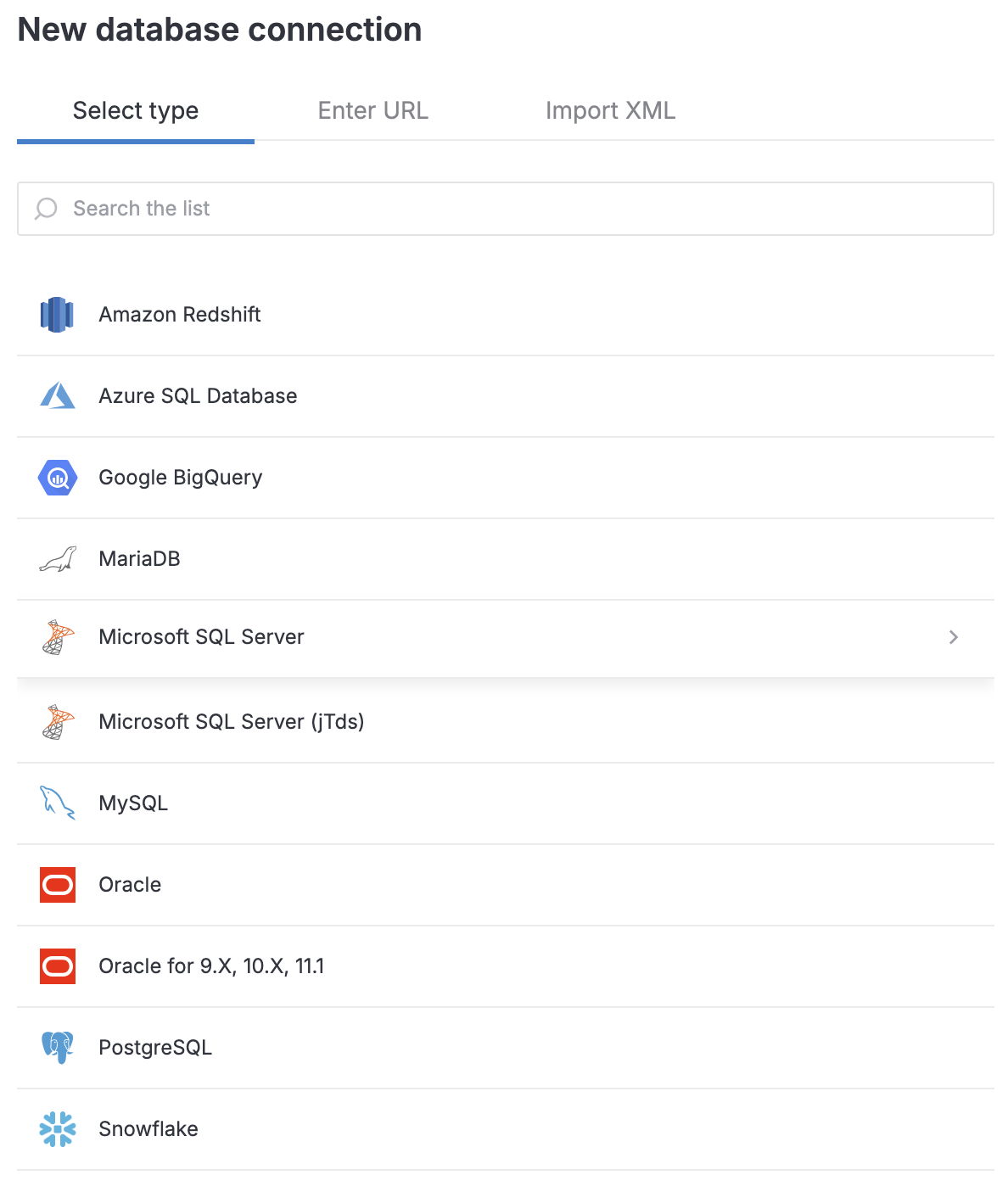Amazon Redshift
This procedure explains how to configure an Amazon Redshift database connection.
Open the New Amazon Redshift connection dialog. Select the tab for one of the two options:
From the editor, to attach the new database connection to a specific notebook
From the Home page, to add a database connection to a workspace
Notebook/EditorWorkspace/Home pageOpen the Attached data tool from the left-hand sidebar.
Switch to the Databases tab. You will see the list of all database connections available from the respective workspace.
At the bottom of the tab, click New database.

In the New database connection dialog, select Amazon Redshift.
On the Home page, select the workspace where you want to create the connection.
In the selected workspace, go to Data | Databases.

Click the Add button in the upper right corner. The New database connection dialog will open.
In the New database connection dialog, select Amazon Redshift.

On the General tab, select the connection type.
Default: to connect by specifying the Host, Port, and Database.
IAM cluster/region: to connect by using Database, Region, and Cluster.
URL only: to connect by providing the URL of a pre-built connection.
note
Use this method to pass additional parameters. For example, add
&SSL=trueto the URL string to enable SSL.
Proceed based on the selected connection type:
defaultIAM cluster/regionURL onlyIn the Host field, type your server address.
In the Port field, type the port of Amazon Redshift. The default port is 5439.
note
Real port numbers might be different on your system. Verify that you use a correct port number with your database administrator, server settings, or hosting provider.
From the Authentication list, select the authentication method that you want to use to authenticate the connection. The following options are available:
User & Password: by using your login and password.
AWS Vault AppRole: by using AWS Vault for your AWS credentials. Visit this page for more details.
AWS profile: by using a named profile. A named profile is a collection of settings and credentials that you can use for authentication. Named profiles are stored in CREDENTIALS files. Default directories for these files are ~
/.aws (Linux and macOS) and %USERPROFILE%/credentials \.aws (Windows).\credentials No auth: without authentication.
In the User and Password, provide your credentials if required by the selected authentication type.
In the Database field, enter the name of the database to which you want to connect.
From the Authentication list, select the authentication method that you want to use to authenticate the connection. The following options are available:
User & Password: by using your login and password.
AWS Vault AppRole :by using AWS Vault for your AWS credentials. Visit this page for more details.
AWS profile: by using a named profile. A named profile is a collection of settings and credentials that you can use for authentication. Named profiles are stored in CREDENTIALS files. Default directories for these files are ~
/.aws (Linux and macOS) and %USERPROFILE%/credentials \.aws (Windows).\credentials No auth: without authentication.
In the User and Password, provide your credentials if required by the selected authentication type.
In the Database field, enter the name of the database to which you want to connect.
In the Region field, enter the AWS Region of the database that you are connecting to.
In the Cluster field, enter the name of Amazon Redshift cluster that contains your database.
From the Authentication list, select the authentication method that you want to use to authenticate the connection. The following options are available:
User & Password: by using your login and password.
AWS Vault AppRole :by using AWS Vault for your AWS credentials. Visit this page for more details.
AWS profile: by using a named profile. A named profile is a collection of settings and credentials that you can use for authentication. Named profiles are stored in CREDENTIALS files. Default directories for these files are ~
/.aws (Linux and macOS) and %USERPROFILE%/credentials \.aws (Windows).\credentials No auth: without authentication.
In the User and Password, provide your credentials if required by the selected authentication type.
In the URL field, provide the URL of the pre-built connection you want to establish.
(Optional) For other options (SSH tunneling, scope inspection, or additional connection parameters), switch to the respective tab of the dialog and follow one of these procedures.
Click the Test connection button at the bottom of the dialog.
Once the connection is successfully tested, click the Create and close button.
If created for a specific notebook, the new connection will be automatically added to the workspace. You can later attach this database connection to any other notebook from this workspace.
If created for a workspace, this connection is added to the workspace databases and can be attached to any notebook from this workspace.
To retrieve and process data from the connected database, use Query data with SQL cells.